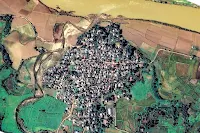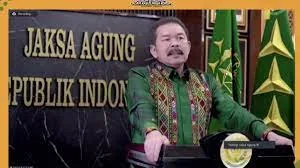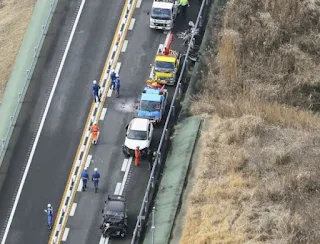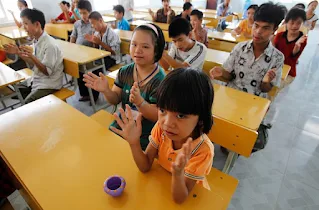Satellite imagery shows the burnt village of San
A total of 132 houses were set on fire on January 18 after troops entered San village in Gangaw Township, Magway Division.
Satellite view of a fire in San Myo Village, Gangaw Township, Magway Division.
RFA's satellite imagery shows that almost the entire village of San Myo Ywa, Gangaw Township, Magway Division, was burnt down on January 18.
On January 18, about forty-five members of the military council entered the town of San with heavy artillery fire, forcing the entire village to flee, villagers said.
The ashes of San Myo village, where about 130 houses were burnt down amid green fields along the meandering Myittha River, can be clearly seen from the sky.
Photographs obtained by the RFA provided video footage of the Nankha youth group showing the burning of San village on the night of January 18 and the devastation of the fire on January 19.
The satellite image, taken on January 23 and two years ago, shows the town of San before and after the arson attack. In the village of more than 190 houses, only 30 houses remain and about 1,000 villagers are sheltering in nearby villages, locals said.
According to an audio file released this week by the banned modern media, the Magway Division Security Minister admitted at a meeting that the junta's administration had collapsed in three townships in Gangaw District.
Myanmar Data, which covers the aftermath of the coup, told RFA in early January that since the coup, 1963 houses had been set on fire in 90 villages across the country, with more than 400 fires in Magway Division alone.
The military council has not commented on allegations that the military set fire to the town of San. Villages The military council says the arson attacks in cities are the work of PDF groups, but eyewitnesses say they are the work of the military.
Attorney General: Sentencing corruptors to death is a manifestation of eradication
Jakarta (ANTARA) - The Attorney General of the Republic of Indonesia, Sanitiar Burhanuddin, said that punishing criminals to death is the maximum manifestation of efforts to eradicate corruption in Indonesia, which resembles an iceberg phenomenon.
“Corruption in Indonesia is an iceberg phenomenon, where thousands of cases have been revealed and thousands of perpetrators of corruption have been convicted. However, the quality and level of state losses are increasing," said Burhanuddin.
He made this statement when giving a presentation in a public lecture entitled "Effectiveness of Legal and Economic Handling in the Mega Corruption Case: The Jiwasraya Case Study" which was broadcast on the YouTube channel of Atma Jaya Indonesian Catholic University, monitored from Jakarta, Wednesday.
He said that if you look at the various criminal sanctions that have been given to corruptors, it turns out that it only creates a deterrent effect for the convicts not to repeat their crimes.
The deterrent effect, said Burhanuddin, has not yet reached the general public. This can be seen from the emergence of the seeds of new corruptors who are actually changing and growing everywhere.
"We need to think about it together, it turns out that the pattern of criminal sanctions that have been imposed on corruptors only has a deterrent effect on the convicts," he said.
Therefore, Burhanuddin said, both law enforcement officers and legislators must think about what kind of deterrent effect can be the most effective warning for the public not to commit acts of corruption.
One of the instruments that can be considered is the application of the death penalty which is the type of punishment listed. Basically, said Burhanuddin, the prosecutor's office conveys a strong message to everyone who has the potential to commit a crime of corruption to immediately stop his intention. "We remain committed to eradicating serious
crimes of corruption, which must be carried out in an extraordinary way."so that justice can be enforced in a measurable, effective manner, especially in handling corruption cases on a mega-corruption scale,” said Attorney General Burhanuddin.
12 cars in multiple collision, 19 injured "Fog is amazing" on the Chiba / Ken-O Expressway
Is it the appearance of an examinee who is suspected of leaking common te?
Trailer rollover at Hanshin Expressway
The site of the Ken-O Expressway where there was an accident involving a large number of cars = 11:38 am on the 27th, Kisarazu City, Chiba Prefecture (from Kyodo News helicopter)
At around 8:05 am on the 27th, there was a number 110 saying, "There was an accident involving about 10 cars. The fog is amazing" around the inner loop of the Ken-O Expressway (Ken-O Expressway) in Mariyatsu, Kisarazu City, Chiba Prefecture. rice field. According to the prefectural police and fire department, a total of 12 wagons and passenger cars collided, injuring a total of 19 people.
The site is a one-lane, two-way road between the Kisarazu East Interchange (IC) and the Ichihara Tsurumai IC. At that time, a thick fog warning was issued in Chiba prefecture, and the prefectural police investigated that the fog might be the cause.
VN expert: Can the US increase medical support for Agent Orange victims?
The event was organized by the American Institute of Peace (USIP) and brought together a number of panelists including people who have special interests in dealing with the consequences of Agent Orange, also known as herbicides with dioxins. considered to be devastating to the environment and affecting the health of many Vietnamese soldiers and civilians.
Data from the USIP reaffirms that from 1961-1971, four years before the end of the Vietnam War, the US military sprayed a large amount of herbicide over an area of more than 26,000 square kilometers in combat zones. between the two sides.
Mr. Andrew Wells-Dang, a senior expert on Vietnam at the American Institute of Peace, opened the conference thus:
“ About one million to 4.8 million Vietnamese and hundreds of thousands of American soldiers were directly exposed. Under the Agent Orange Act of 1991, many U.S. veterans have received assistance with Agent Orange-related ill health.”
“When the war ended, the North Vietnamese soldier returned home with dioxin effects in his body. This means that people exposed to orange substance can be found all over Vietnam. The Vietnam Red Cross estimates that three million Vietnamese have been affected by dioxin, including at least 150,000 children born after the war with severe birth defects.
According to Mr. Andrew Wells-Dang, in 2006 the United States began to cooperate with Vietnam to overcome the consequences of Agent Orange. The US government has contributed more than 125 million USD to support people with disabilities due to dioxin contamination in Vietnam. There are 10 Vietnamese and international organizations currently providing funding services to people with severe disabilities in eight central and southern provinces, where dioxin exposure is greatest.
One of the most important works is to cooperate towards cleaning up the environment:
“The United States spent $112 million on remediation of the dioxin-contaminated environment in Vietnam with the Vietnamese Ministry of National Defense. The second cleanup project started in 2020 at Bien Hoa Air Base, the remaining Agent Orange hot spot.
Enter the keynote speakers. The first, Mr. Charles Bailey from the Aspen Institute, has been the representative of the Ford Foundation in Hanoi since 1997, followed by the former Director of the Orange Program in Vietnam.
Mr. Bailey said that when he came to Vietnam in 1997, he quickly realized that Agent Orange was a problem that had not been solved yet.
“I felt like we should really do something about Agent Orange, our government should be proactive. But everything seemed to stand still, so we tried to remove all obstacles.”
“ I proposed and the Ford Foundation approved grants that directly help dioxin victims. We try to tell Americans about the impact Agent Orange dioxin is having on the Vietnamese people. In addition, we have the idea that it would be very good to have a two-way communication channel between the two countries, through which Americans and Vietnamese can share, propose new work and an immediate solution."
This idea helped form the US-Vietnam Dialogue Group on Agent Orange. The Vietnam-American Dialogue Group on Agent Orange operated for seven years, from 2007 to 2014. Its members and experts are free to learn, discuss, and visit Agent Orange victims and their families as well as their families. visit dioxin hotspots in Vietnam.
Area signs with dioxin near Da Nang airport, which was a former US base, an Agent Orange hot spot in Vietnam. Photo taken on August 9, 2012. AFP
After that, according to Mr. Charles Bailey's words, a solution roadmap was established, which became a statement and action plan with two goals of cleaning (Cleanup) and supporting people with disabilities including many priority measures. over three 10-year periods at $300 million in costs. That is the starting point.
“ The US Congress has approved more than 400 million USD for the Agent Orange problem, 30% of which is for the health and health of the sick, 70% for dioxin cleanup.”
Organizations such as Ford Foundation, Rockefeller, UNDP United Nations Development Program, UNICEF United Nations Children's Fund, HSBC are a series of donors of large sums of money to victims of Agent Orange dioxin, for the work clean up the environment of Da Nang and Bien Hoa airports.
“ Since 2015, we have gone further in identifying who are victims of serious injuries from dioxin to prioritize support for them. This funding requires thought and discussion between both countries. How America's health and disability support has the best and most meaningful impact on the Vietnamese people is our goal.”
In response to Mr. Charles Bailey, Ms. Susan Berresford, former President of the Ford Foundation, who used to convene the US-Vietnam Dialogue Group on Agent Orange, took this opportunity to present her difficult and delicate experiences in the process. Working of the Agent Orange Dialogue Group:
“ We were met with skepticism that the two countries could hardly, or even should, work together, and that was the driving force behind the creation of the Agent Orange Dioxin Dialogue Group. We invited reputable people from both countries and I was asked to be the convenor. In that role, I held meetings, led discussions, wrote letters or spoke to anyone we thought could help.”
Over the past 14 years, until she left the Ford Foundation, Susan Berresford continued, she continued to help as much as she could and looked back on her experience:
“ I would like to present my three observations and thoughts under the three words Plan, Pressure, and Principle. One shortcoming in our efforts is our inability to forge a framework where both sides can work towards a mutually acceptable solution.”
The US government, Ms. Berresford explained, is always asking us how we can call it enough. Our partners in Vietnam seem uncomfortable in a dialogue to define what is acceptable regarding Agent Orange dioxin victims:
“ We need a very clear definition of what a victim of Agent Orange dioxin is, the best possible plan for all of that.”
“ Secondly, in mobilizing to find a solution, we are not under much pressure. There are certainly people interested so the breakthrough happened. I don't think there's anything wrong with each of those processes, but a larger resolution is needed as the dioxin issue is quite sensitive so far. So I hope the innovation effort can be organized around a plan with the pressure behind it being the principle of once and for all funding. I believe and hope can continue to be effective in some way.”
The third speaker, Mr. Phan Xuan Dung, an expert at the ISEAS-Yusof- Ishak Institute for Southeast Asian Studies in Singapore:
“ I was born long after the war ended, but I learned a lot from the stories of my father, a North Vietnamese soldier who was sent to the battlefields of the South in the late 1960s. He told me one day. One day, he saw a plane spraying herbicides very close to where he was stationed. Father still remembers that image vividly with the fear that he was breathing in something very toxic. Fortunately, my father did not suffer any health effects related to that smoke, but millions of Vietnamese and hundreds of thousands of American adults exposed to dioxin were not as fortunate as my father, including many children. me too".
The consequences that we can see, Mr. Phan Xuan Dung emphasized, are that the spraying has stopped for 50 years, but the terrible consequences of Agent Orange still linger, still echoing through generations:
“ But we can do something about this, as we heard from Charles and Susan that Vietnam, and the United States, have come a long way on the Agent Orange issue.”
“It is thanks to the unremitting efforts of a number of key people, including US Senator Patrick Leahy, and with the support of the American experience in Vietnam, that the solution to AO dioxin has become a reality.”
Addressing the consequences of Agent Orange, researcher Phan Xuan Dung from the ISEAS-Yusof Ishak Institute affirmed, is an important aspect of the US-Vietnam bilateral relationship, creating conditions for trust and building. and heal the wounds of war.
“ The Vietnamese Defense Minister emphasized the importance of long-term cooperation, that without this cooperation there would be no foundation for current and future relations.”
“ However, I would like to emphasize that there are still three challenges that stand in the way of reconciliation. The first challenge is that there are several gaps in current US funded health programs. These programs are limited in scope, covering only major priority provinces. The Vietnam Association of Agent Orange Victims has emphasized that there are many provinces where victims need assistance. Furthermore, these programs focus more on capacity building than direct assistance, while direct assistance is the best way to reach and transform the lives of people disabled by Agent Orange. ".
A larger amount of funding is needed if we want to provide more direct support, he said, but it is unclear whether the US is willing to increase annual funding for health activities in Vietnam. Are not.
“ The second challenge is the 'risk prevention language' of the United States on the health effects of Agent Orange dioxin on Vietnamese people. These overly careful language allows the United States to work with Vietnam on the health effects of Agent Orange without acknowledging any official responsibility.”
The defoliant companies in question claimed that they were not responsible for being forced by the US government to produce herbicides for the war. But in 1984, they had to pay $150 million to a number of American veterans, in contrast to their decision not to compensate Vietnamese victims of Agent Orange.
These are the things that interested people must ponder, Mr. Phan Xuan Dung emphasized:
“Nothing is impossible in reconciliation. Two important lessons that I think can be applied to the Agent Orange remedial issue to promote deeper reconciliation.”
So what needs to be done is to build positive relationships and engage in dialogue with victims and their representatives. We need to understand that perspective and experience to provide more effective and meaningful support, concludes Mr. Phan Xuan Dung.
The webinar ended after an hour of discussion and Q&A around the process of remediating the consequences of Agent Orange dioxin for Vietnam as well as the program's direction in 2022.





